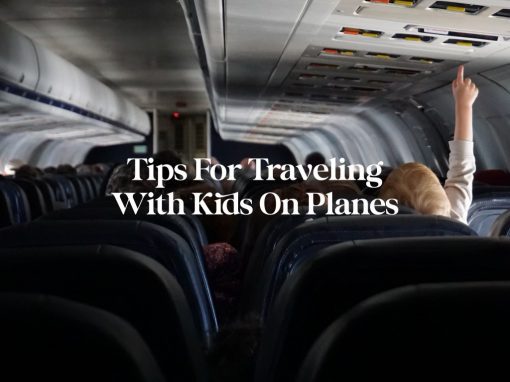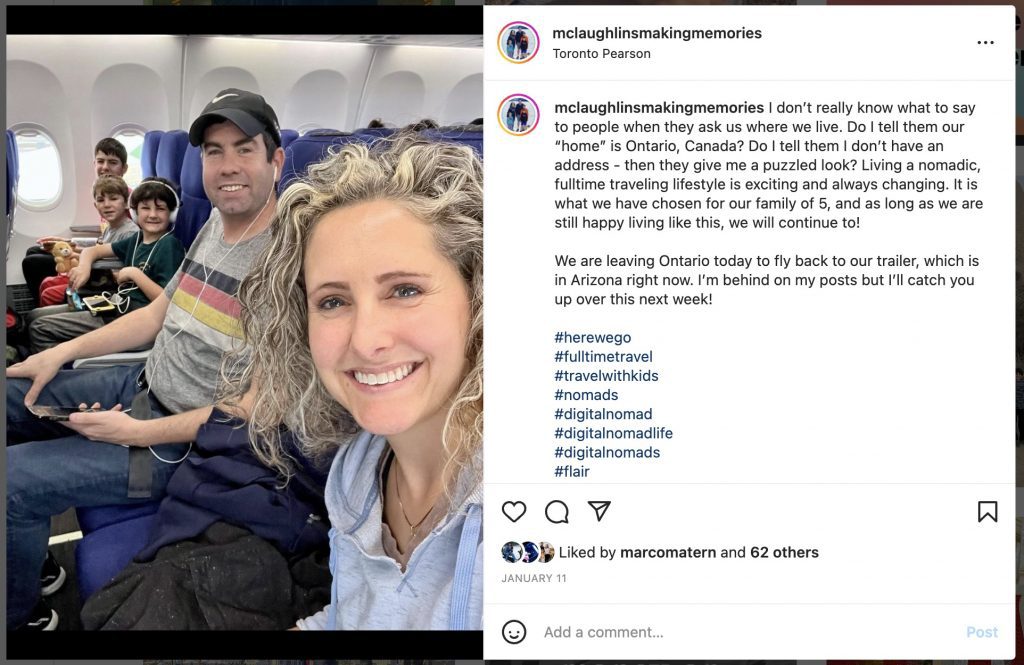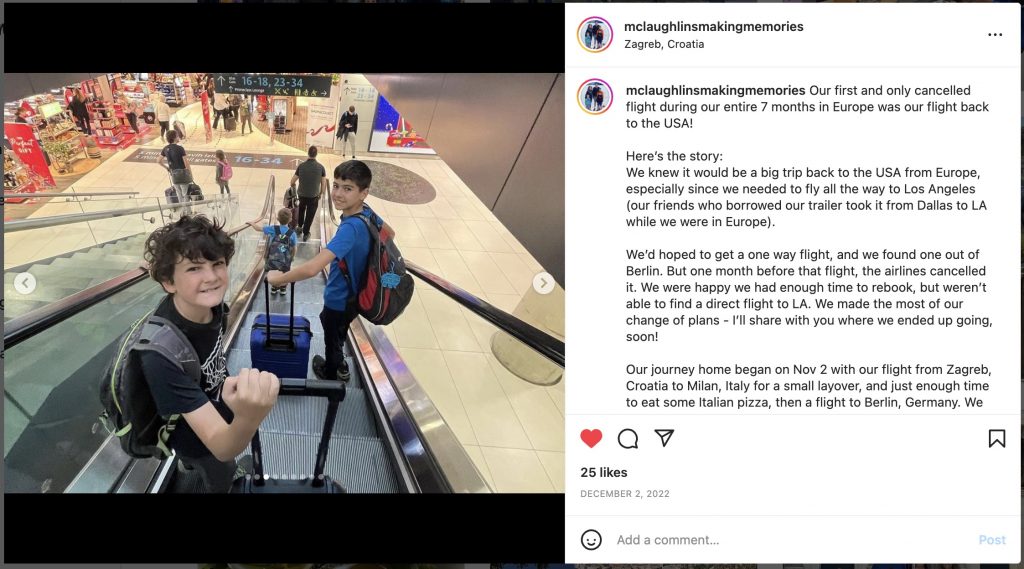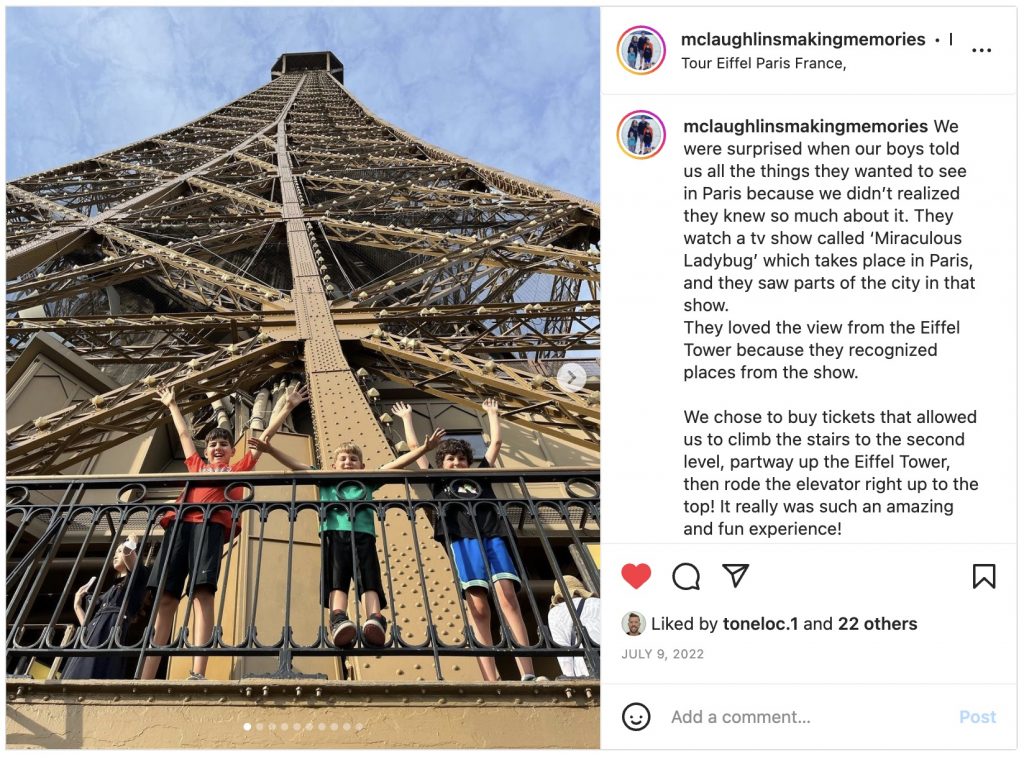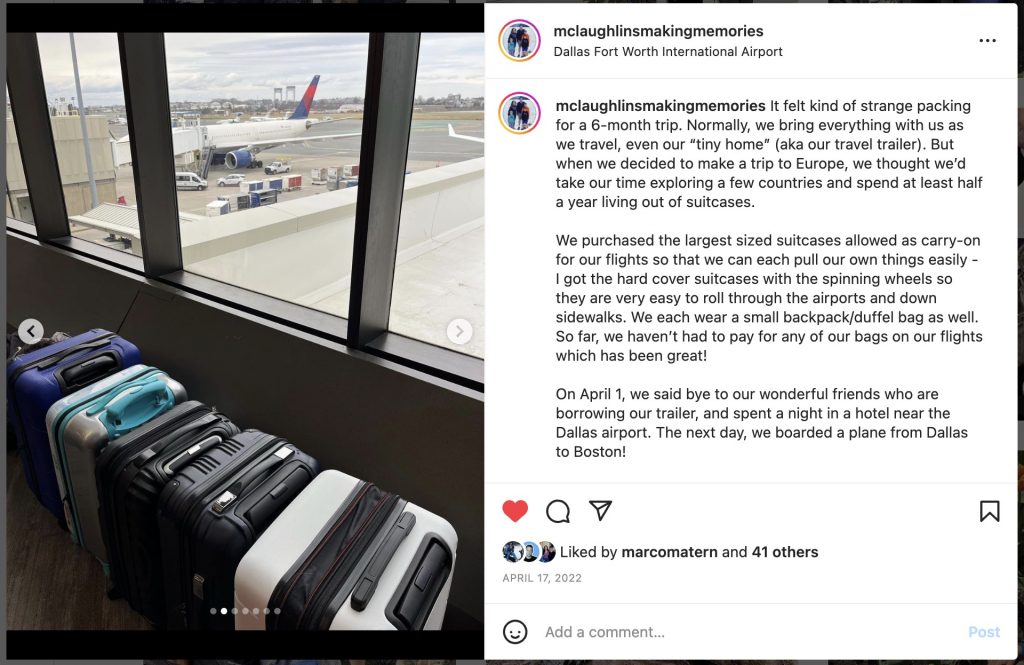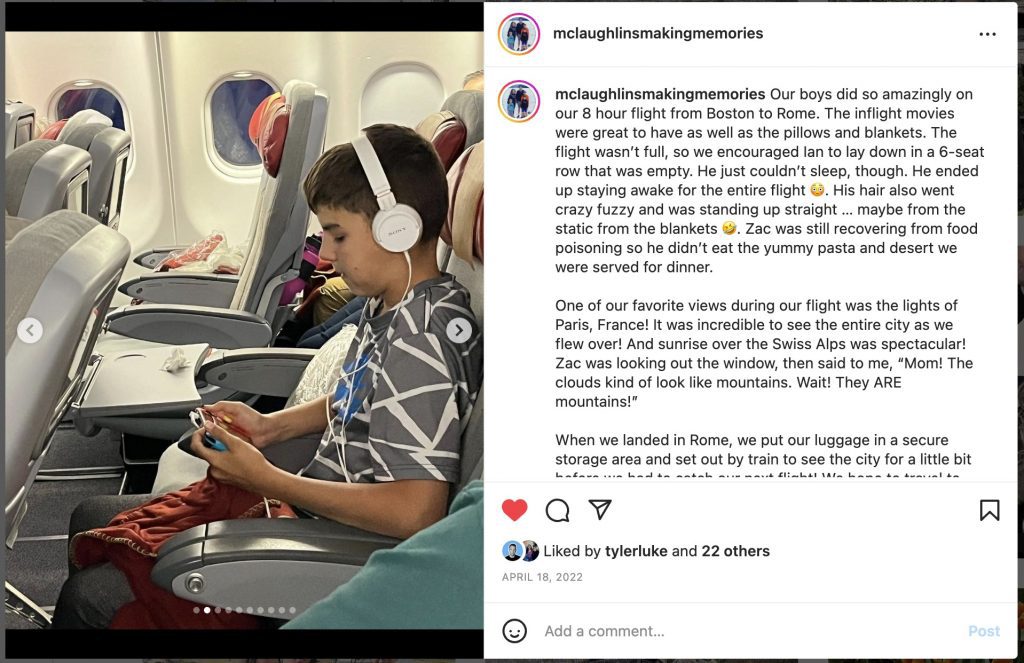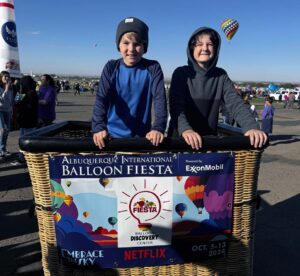You’re taking your kids on a plane for the first time:
- You’ve got your kid’s clothes, toys, and snacks packed, but will it be enough?
- Will younger kids sleep on that long-haul flight?
- Will older kids have enough to do to keep them occupied while they sit in one spot for hours at a time?
- Will the flight attendants babysit if you fall asleep? (probably not)
Here’s what you need to know about making your family plane trip as smooth as possible, including things to do with kids on planes, but also what to expect in the airport and how to set the tone and expectations for the rest of your trip.
We’ve taken plenty of plane rides as a family, so this is a compilation of things that we’ve experienced personally on shorter flights around North America (and longer flights to Europe) but also great ideas we’ve observed from other families while traveling.
Preparing Your Kids For Security Before You Get To The Airport
For small children, airport security measures might seem scary, especially if they aren’t expecting people in uniforms carrying guns and give instructions to dozens of strangers in line.
Depending on their age, an unprepared child might have these concerns at airport security:
- People with uniforms
- Walking through the metal detectors.
- Will they get their things back after they put them through the metal detector?
- Why do mom and dad have to take their shoes off?
- Why can’t I stay with Mom and Dad? Why do I need to go into the metal detector machine alone?
Knowing your child and their personality, take time to prepare them well in advance of the trip.
Practice what will happen at airport security with your kids
Remember, your child will have to go through airport security procedures. Explain what will happen and what your kid may feel during the process, especially for young kids. Nothing will touch them, and they won’t feel anything during the metal detector.
In-depth security checks or seeing the canine unit at security is unlikely, but it’s not probable that you will be skipped because you are traveling with children.
Even babies and pregnant women are not exempt, and if you’ve watched any of the border security shows on TV, you’ll know exactly why.
Both big kids and little kids love to pretend, so take turns pretending you’re a security officer giving instructions, then let them pretend to be the officer.
Talk with your child about things they’ll see and hear at the airport:
- The roar of the planes taking off.
- The intercom makes announcements about which gate to be at for your flight.
- Beeping scanners.
- Restaurants and Stores.
- Security Dogs check to be sure everyone is safe.
- A long hallway to get from the door to the plane.
Explain to your child that the x-ray machine helps security guards ensure that everyone getting on the plane is safe by checking for things that aren’t supposed to go on a plane.
Practice putting their toys in a plastic bin or tray to go through a pretend scan. If you have a local museum, library, or sports arena that has a metal detector, take them to go through there to practice when you don’t have a deadline of getting on a plane.
Avoid talking about bombs, guns, or terrorist attacks. These are enough to concern adults and information that children don’t need when they’re thinking about their trip.
Let your kids know that security may ask everyone to remove their shoes. This is another way to be sure we’re safe, and we’ll get our shoes back after they go through the scanner.
By talking with your kids about what to expect during security, they’ll have clearer expectations and less apprehension about the unexpected.
Packing Your Carry-On Luggage For A Plane Ride With Kids
It’s incredibly frustrating to find yourself needing something only to dig through your carry-on bag and not find it or realize you put it in your checked baggage which won’t do you any good at 30,000 feet.
It’s difficult to remember what is or isn’t allowed in your carry-on (plus, the rules continually change, so always check the airline’s website).
Here’s a list of what to put in your carry-on bag when flying with kids
- Diapers – Figure one diaper per hour in the air. While it’s likely you won’t need this many, it’s better to have too many than not enough. You’ll want to balance being prepared with too much in your diaper bag, so don’t go overboard.
- Baby wipes – Wipes are convenient and versatile; perfect for cleaning diaper messes, but also messy hands, faces, and a quick grab for a small spill.
- Comfort items – Bring along your young kid’s favorite snuggle toy or blanket (depending on their age). For older kids, you’ll know what’s the best thing to have on hand to comfort them.
- Small blanket and/or pillow. These 2-in-1 pillow blankets for airplanes are perfect since they’re just the right size, and can serve both purposes easily.
- Snacks – Most airlines will serve some snack, but it may be an hour into the flight or not a snack that suits your child’s tastes. You may also need a snack in the link boarding the plane when you don’t have time to run to the nearest convenience store. Good airplane snacks include dried fruit, crackers, cheese sandwiches, and dry cereal. Bring baby food if your baby is still at that stage (but something that won’t smell up the whole plane.)
- Drinks – Airplane air can be dry. Be sure to bring plenty of bottled water for you and your kids. While you can’t take water through security, you can take an empty bottle and fill it when you get through security to take it on the plane with you. If your young kids need it, bring their sippy cup.
- Activities – There isn’t much to do on an airplane, and there’s no guarantee that your plane will have in-flight entertainment or plugs for charging devices, even though many planes do. Bring coloring books and crayons, books to read, and a favorite toy. Don’t bank on that iPad just to find out you’ve run out of battery with no way to charge it halfway through your flight.
- Extra Clothing – Spills and accidents happen (and let’s not mention lost luggage). Remember to pack at least one change of clothes for each of you, so if you have a spill, you’ve got something comfortable to wear on the plane, and if your luggage gets delayed, you’ll still have a change of clothes for your destination.
Here’s the airplane luggage we used to travel as a family of five for seven months in Europe.
Easing Your Child’s Fears About Air Travel
Flying in a real airplane can be overwhelming for some children. Putting their things in suitcases, getting on a huge airplane, and leaving their home, pets, and everything they love behind can create some concern.
This is a brand new experience for them, and they might have concerns about how it will all play out, so let them know what to expect and you’ll have a smooth flight.
Don’t forget to talk about details like getting help from flight attendants if needed, putting your belongings in the overhead bins, and ensuring that every passenger (including your kids) has a separate seat with seat belts.
Talk about what takeoff, landing, and unexpected turbulence feel like so there are no surprises as they experience flying (and your experience flying with kids) for the first time.
It’s also good to mention that there is a bit of a delay between getting on the plane and taking off while the flight attendant ensures everyone is seated and the plane taxis to the runway.
Explain where you will be going and how your family will be flying to get there
Whatever the reason for your trip, talk to your child about why you are going. If you’re going to be petsitting, talk about the pet you’ll visit. If you’re going to be sightseeing, watch a video about the historical site you’ll visit.
Let your child help decide what they would like to do at your destination – this could be as simple as wanting to eat at their favorite restaurant (even if you have that same restaurant in your hometown – for our boys, it’s always McDonalds).
Your child will be much more enthusiastic about the trip if they are confident about some of the things they’ll get to experience.
Let your child know who will care for any family pets while you’re gone. If your child hasn’t met them, have an introductory meeting, or tour the kennel where your pet will be boarding.
Ask if you can schedule a Facetime call while you’re away so your kids can visit with their pets and reassure them they’ll be back soon.
Removing the fear of the unknown is a solid foundation for having a worry-free trip.
What To Expect At The Airport With Kids
Airports are crowded and busy and are very safe if you stay alert. With today’s airline security restrictions, getting through check-in and boarding quickly is almost impossible, so give yourself plenty of time.
Here are a few things to make your airport experience with kids as pleasant as possible:
- Check the airline’s website to find your luggage’s acceptable size and weight. Here’s how we chose the best luggage for our kids while spending seven months in Europe.
- Double-check that everything you plan to pack is allowed in your carry-on or stowed luggage. Some items are allowed in checked baggage but are not allowed to be carried on. These standards change occasionally, so just because it wasn’t a problem last time doesn’t guarantee the same this trip.
- Get to the airport on time. Plan to arrive at the airport several hours before your flight is scheduled to leave, usually 2 hours for a domestic flight and 3 hours for an international flight, but depending on the size of your local airport and how many kids you’re traveling with.
- Make the airport part of your vacation. Go earlier to the airport and make the trip part of your vacation, not just the destination. Grab some lunch at the airport, take some selfies by the art with your kids, and relax, knowing that you’re not anywhere close to missing your flight.
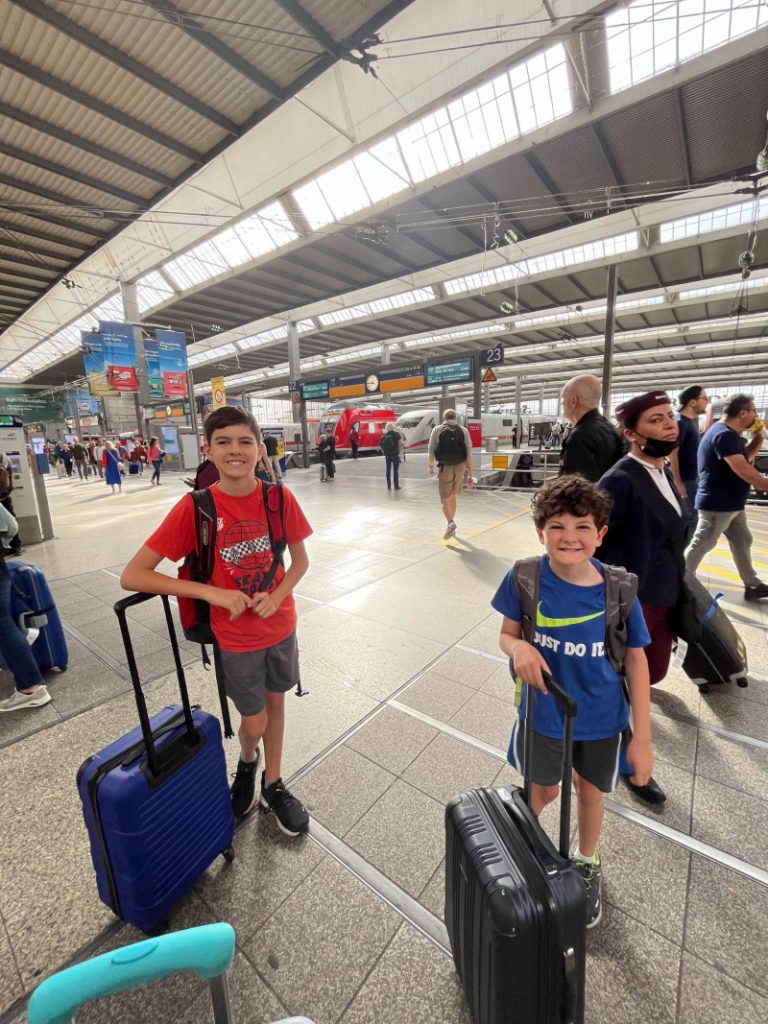
What To Expect with Airport Security With Children
Before going to airport security, take a break in the family restroom
The “I have to pee now” challenge is one of the nine challenges that traveling families face! Better to be proactive.
Let your kids get a quick drink, and remind them to empty their water bottles before security. They’re not allowed to take liquid through (milk for a baby is usually an exemption), but they can fill their water bottle on the other side of security before they get on the plane.
Over the last several years, airport security measures have changed quite a bit.
If you haven’t flown in a while, there are a few things you should know:
Everything must go through an X-Ray machine, including strollers, car seats, toys, and all other objects. Fold your stroller and remove small toys, electronics, or other items from storage pockets before putting them on the conveyer belt.
Put them in the plastic bins provided, so everything is kept together on the other side of the security scan.
Make sure to let your young ones know what to expect ahead of time. It’s best to pack electronics (like a tablet) at the top of your carry-on baggage, so it’s easily accessible both on the plane and to take out to put in the bins in security. You won’t want to have to empty your bag to get that one device out of the bottom.
Reassure your kids that you’ll pick up your belongings on the other side.
If you’re traveling with a baby, never walk through the metal detector with your car seat. You’ll need to remove your child from their seat, carrier, or harness as you go through security so the baby’s carrier can be inspected.
As a parent, don’t feel any pressure to rush through airport security
The security department wants to keep everything moving, but while some people can get impatient, most people understand the challenges of traveling with kids and will understand the short delay.
Remind your children to empty their pockets before going through the metal detector (or, better yet, before getting to security). The security checkpoint is not the place for games, and remind your kids to treat that space with respect so they (and other traveling families) can move through as quickly as possible.
If you’re traveling with two adults, have one go through the metal detector first, then the kids, then the second adult last.
This way, your kids will have someone on both sides if they need some clarification or instruction.
If you’re the only adult, have your older child go through the metal detector first so that you can keep visual contact with her/him and carry younger children.
If the metal detector goes off and you are carrying your child, both you and the child will be further examined by security. You will probably be asked to remove your shoes (if they haven’t already), and they may scan you and your young ones with a wand.
They may ask your kids to remove their shoes (though this doesn’t happen often). Don’t wear those shoes that are a pain to get on or off. Velcro, slip-ons, or a single lace are great options.
If traveling with a baby or toddler, you can carry milk or formula in your diaper bag, but no other liquids over 4 oz.
You can request a private security screening if you are traveling with more than one child or if your child has a disability and requires special care.
Getting Around The Airport With Kids
Keep Your Attention On Your Kids
Distraction is a kidnapper’s dream. It’s a terrible thought, but one to be aware of. Busy, distracted parents and bored, excited children are dangerous combinations, especially pre-security – in the parking lot or ticket lineups steps away from the front door.
Give your child your full attention by carrying as little as possible. Bring a luggage carrier or have a friend drive you to the airport and help you with your luggage. This isn’t a time to be on your phone and let your kids do their own thing.
Find things you can do together, so you’re aware and alert while waiting for your flight – watching a movie, reading a book, or playing cards together will keep your attention on each other.
Know where your departure terminal is
It is no fun to think you know where you’re supposed to be only to find that you’re at the wrong terminal.
The last thing you want to add to your day is running through an airport and dodging crowds with kids. It’s stressful and increases the chances you’ll miss your flight if you’re in the wrong place at the wrong time.
Before you get to the airport, find out which terminal your flight leaves from so you don’t have to make multiple stops on arrival. Once you get to your gate, listen for intercom messages and check the flight board over your gate often to find out if anything has changed.
If you are flying with connecting flights (a great way to save money), ask the flight attendant close to the end of your first flight if he or she can find out where your connecting flight gate is so you know if you need to turn left or right when you get to the terminal, and you don’t have to stop and find out yourself.
If you have a long layover, it may be worth taking a trip in to see the city instead of sitting around the airport. That’s how we snuck in 3 extra countries while visiting Europe.
Things To Do With Kids On A Plane
(aka Keeping Your Kid Occupied On An Airplane)
Being on an airplane with a bored child is not a fun experience for you, the other passengers, the flight attendants, or your child. Young children cry or whine, and older kids might try to goof off loudly, which can bother other passengers seated near them (who already may have some apprehension about flying).
Activities to Pack When Flying With Kids:
Plan a more pleasant trip for you, your kids, and other passengers by planning ahead and packing plenty of activities for your kids.
- Pocket versions of popular board games (like this magnetic checkers travel set) will entertain the kids and won’t take up much space in your carry-on bag. Most pocket or travel versions of board games are magnetic to minimize the risk of pieces getting lost or falling off the board during play. Make this extra special by wrapping the game so your kid has an extra step and a surprise on the plane. Every minute counts!
- A deck of playing cards. Children enjoy playing many card games, so this might be a great time to teach them a new game, or simply ask if they want to play one of their favorites. For younger kids, this playing card holder helps them see all of their cards at once without dropping any on the floor.
- Etch-a Sketch and Magna Doodle are self-contained games that that allow your child to draw, write, or play games such as hangman without having to have a pen (plus an extra in case the first isn’t working) a pad of paper.
- Travel kits that include coloring books and crayons are light and don’t take up much space. They’re great for children of all ages, which is perfect if you’re traveling with more than on kid. Each kid can draw on their own to suit their tastes. Check out this travel kit.
- Favorite books. Reading a familiar book for a young child is comforting and will help take your child’s mind off of being stationary on a plane. If your older child is reading a series of books, you could gift them the next book in the series on the flight.
- Take turns telling each other a story. One person starts by giving one or two lines of the story, the next person continues with the story until they have no more to add. Continue around until the story is finished. It might be fun to record the story on your phone as audio or video to share with family and friends at your destination.
With a little planning, you can keep your kids occupied and have fun on the plane. A great outgoing flight sets expectations for a peaceful and enjoyable return flight too.
What To Do About Kids Popping Ears On A Plane
When flying with babies, young toddlers, and first-time flyers of any age, the most challenging part of the flight is likely to be take-off and landing. Air travel is not all that different than the hum of the engine on a car ride, but take-off and landing are different experiences for your kids.
As the plane gains altitude, the cabin pressure changes and affects the air pressure around the inner ear, creating that “popping ears” effect. The eardrum pressure can be uncomfortable enough for an adult but painful for a baby or small child who doesn’t know to pop their ears by yawning or swallowing.
Experienced traveling parents know there are a few tricks you can use to help minimize the pressure and keep your child comfortable.
Making take-off more pleasant for your child doesn’t guarantee an entire flight of relaxation, but it can help
- If you’re flying with a baby, plan and schedule a fight close to regular feeding time. A bottle is the most effective way to calm your fussy baby and minimize that inner ear pressure through swallowing. A pacifier as the plane takes off may also be helpful.
- For toddlers, try putting cotton balls in their ears before taking off. This additional barrier will help minimize the pressure.
- Stash their favorite blanket or cuddle toy in your carry-on bag and give it to your child before taking off and landing. Be sure not to leave this in your checked baggage. This extra bit of comfort can take their mind off of any other new or unusual sensations.
- Older children can play a game of making funny faces, opening their mouths as wide as they can to clear their ear canal, and chewing gum is also a fun way to release the pressure. Before the flight teach your kids to pop their ears by holding their noses and gently blowing.
A more pleasant flight for your kids, yourself, and your fellow passengers starts with taking a few steps to prepare properly for your flight.
Helping Your Child Get Over Jetlag
Jet lag leaves adults tired, cranky, and many times physically exhausted. Adjusting from one timezone to another is often even more difficult for young kids.
Young children, especially, are susceptible to changes in their schedules and can react poorly to sudden time differences.
Easing jet lag for your children makes good sense for everyone.
- Traveling during your child’s normal sleep time in the new time zone will help to make the transition smoother. They will likely nap during part of the trip, so they’re not making a transition and being overtired.
- Avoid sugary or caffeinated drinks, and be sure your kids drink plenty of water. Sports drinks with electrolytes can be an excellent option to juice and soda. Staying hydrated keeps your body ready to adapt. This is good advice for you too. Keeping yourself hydrated will keep you in good spirits if your child needs extra help.
- Avoid junk food. Sugar and high-fat carbs like cookies and chips will make blood sugar unstable and make your child fussier. It may be tempting to go for a soda and cookies when the flight attendants come by on the plane, but try to keep the child’s diet as normal as possible with water and snacks closest to what they usually eat.
- Prepare for the new time zone by adjusting their schedule gradually over a week before the trip. Staying up a bit later or getting up earlier can help adjust your kids’ natural rhythms before the trip. If this is not practical, have your child go to bed in line with the new time zone the day before the trip. When you arrive at your destination, let them nap, but keep them on the new time.
- Physical activity will help your child’s body deal with jet lag, especially if they now need to go to bed “earlier” than usual. Take them for a walk around the new city, a swim in your hotel pool, or let them run through a park when you get to your destination. Moving around the plane can be helpful too. As soon as the seatbelt light goes off, suggest a trip to the restroom with your child.
Parents should remember jet lag affects both adults and children, and children may be unable to think logically to push through the physical effects. Children may need extra nap time for a few days upon arrival at the new destination, but keeping them hydrated without sugar and adjusting their schedule will help make the transition as smooth as possible.
When you get off the plane and head to baggage claim, continue to remind your child of the purpose of your trip and the destination to keep them (and yourself) in good spirits for anticipation.
Enjoy your flight!
PS: If you’re not sure how to pack, we spent seven months in Europe in 2022 house sitting and petsitting, and this is what we figured out about luggage for a family of five.
Planes vs Trains in Europe:
You’ll have to take a plane to get across the ocean, but if you’re going to Europe, you’ll quickly learn that trains are great alternatives to getting around by plane. Here’s how we decided when to take a plane or a train with kids in Europe.

